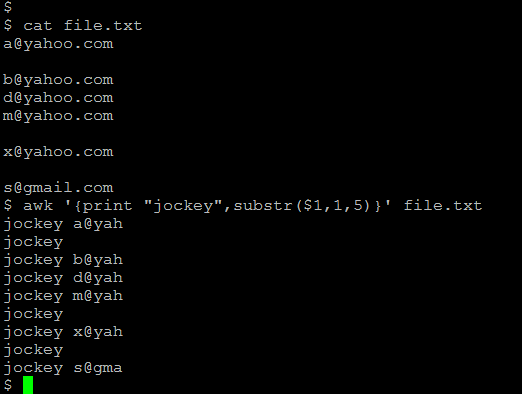
- #BASH AWK SED GREP TUTORIAL MAC OS X#
- #BASH AWK SED GREP TUTORIAL MANUAL#
- #BASH AWK SED GREP TUTORIAL FULL#
- #BASH AWK SED GREP TUTORIAL PLUS#
When to use sedĪccording to the sed FAQ, you should use sed when you need a small, fast program to modify words, lines, or blocks of lines in a text file. McMahon and first appeared in Unix version 7. It is used to perform transformations on an input stream, either a file or input from a pipeline. The target audience is a Bash programmer who knows the basics of sed and wants to learn the rest. In this post, I cover most of the features of GNU sed, nearly all of its commands, but not regular expressions, only the command-line options I consider useful, and my treatment of branching and flow control is cursory. 1 All sed scripts are unquoted unless single or double quotes are reqired to protect characters from interpretation by the shell.
#BASH AWK SED GREP TUTORIAL MAC OS X#
Throughout this post, I use sed in examples for a script that should work in any version of sed, such as the BSD sed that ships with Mac OS X and I use gsed where GNU sed is actually required.

Select from a line to the next line divisible by N.Select from a line or pattern to an offset.The i, a and c commands (insert, append, change).
#BASH AWK SED GREP TUTORIAL FULL#
This post began as a companion to my earlier post, Observations of AWK, and ended up as a full tutorial and reference.
#BASH AWK SED GREP TUTORIAL MANUAL#
I enjoyed reading the GNU AWK manual so much that I decided to read the GNU sed manual too.

All arrays in AWK are associative arrays, so they allow associating an arbitrary string with another value.16 April 2019 A sed tutorial and reference Using Arrays in AWKĪrrays are a powerful feature of AWK. Notice with that latest solution, a record for a user eventually having 0 credits would be discarded too. All of them being equal to 0 when converted to numbers. Non-data records (heading, blank lines, whitespace-only lines) contain text or nothing. In my file, data records contain a number in their first field.
#BASH AWK SED GREP TUTORIAL PLUS#
The unary plus in the pattern forces the evaluation of $1 in a numerical context. It works because of the AWK type conversion rules. This example is mostly useless, but it will nevertheless be a good introduction the AWK syntax: awk '1 ' file However, this subset is already enough to start writing interesting one-liners. There are other more or less standard AWK variables available, so it worth checking your particular AWK implementation manual for more details. If you are using the standard “white space” delimiter for your fields, this will match with the number of words in the current record. NF – The number of fields in the current record. “white space” is the default value for both of them. Usually, FS and OFS are the same, but this is not mandatory. When AWK print a record on the output, it will rejoin the fields, but this time, using the OFS separator instead of the FS separator. Once AWK reads a record, it splits it into different fields based on the value of FS. If you are using the standard newline delimiter for your records, this match with the current input line number.įS/OFS – The character(s) used as the field separator. So if you do not change it, a record is one line of the input file. By default, this is the newline character. The record separator is the delimiter used to split the input data stream into records. AWK processes your data one record at a time. Know Pre-defined and automatic variables in AWKĪWK supports a couple of pre-defined and automatic variables to help you write your programs. You can get a copy of that file online at GitHub. My sample files for this AWK tutorialĪll the one-liners described in that article will be tested on the same data file: cat file This article is not intended to be a complete AWK tutorial, but I have still included some basic commands at the start so even if you have little to no previous experience you can grab the core AWK concepts. Showing you how you can leverage the AWK power in less than 80 characters to perform useful tasks. So, this is exactly the purpose of this article. Sometimes for writing relatively complex programs, but also because of the powerful one-liners you can write to solve issues with your data files.

While sometimes discredited because of its age or lack of features compared to a multipurpose language like Perl, AWK remains a tool I like to use in my everyday work. It is part of the POSIX standard and should be available on any Unix-like system. The AWK command dates back to the early Unix days.


 0 kommentar(er)
0 kommentar(er)
